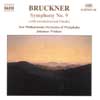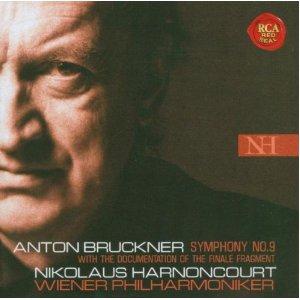Bruckner Symphony No 9
Two new attempts to complete Bruckner’s unfinished symphonic torso with Harnoncourt providing a glorious solution
View record and artist detailsRecord and Artist Details
Composer or Director: Anton Bruckner
Genre:
Orchestral
Label: Naxos
Magazine Review Date: 11/2003
Media Format: CD or Download
Media Runtime: 83
Mastering:
Stereo
DDD
Catalogue Number: 8 555933/4

Tracks:
| Composition | Artist Credit |
|---|---|
| Symphony No. 9 |
Anton Bruckner, Composer
Anton Bruckner, Composer Johannes Wildner, Conductor New Philharmonic Orchestra of Westphalia |
Composer or Director: Anton Bruckner
Genre:
Orchestral
Label: Red Seal
Magazine Review Date: 11/2003
Media Format: CD or Download
Media Runtime: 131
Mastering:
Stereo
DDD
Catalogue Number: 82876 54332-2

Tracks:
| Composition | Artist Credit |
|---|---|
| Symphony No. 9 |
Anton Bruckner, Composer
Anton Bruckner, Composer Nikolaus Harnoncourt, Conductor Vienna Philharmonic Orchestra |
Author: Richard Osborne
Until now, I have been unimpressed by Harnoncourt’s flirtations with Bruckner. Eccentric detailing and a lack of a long-term rhythmic pulse are old Harnoncourt failings to which had to be added the impression that he didn’t yet seem to ‘know’ the symphonies as the old master Brucknerians knew them. That said, this live Salzburg Ninth is glorious. There is no sense here of fallible rhythms or the conductor not being able to see the wood for the trees.
Like all great interpreters of the Ninth, Harnoncourt treats the opening movement as a vast tripartite structure – exposition, countervailing statement, and coda – which can be taken, as it were, in a single glance. Nor is there any falling off in the Scherzo or the great concluding Adagio, both of which are beautifully paced and expertly realised in terms of each new harmonic salient. In beauty of sound and accuracy and articulacy of ensemble, the Vienna Philharmonic matches, even occasionally surpasses, its own high standards in this work. All of which must have helped the Teldex engineers who make the acoustically problematic Grosses Festspielhaus sound like one of the great Bruckner halls.
The Naxos performance is neither as well recorded nor as well played, something former VPO player, the competent and conscientious conductor of the Naxos set, Johannes Wildner, would probably be the first to admit. It is certainly not in the same league as the rival budget-price Tintner or Skrowaczewski performances, both of which have the additional advantage of being single CDs.
Wildner’s isn’t the first recording of a reconstruction of the symphony’s unfinished fourth movement – Yoav Talmi’s 1987 Chandos disc gave us both the raw material and William Carragan’s reconstruction – though it is more ‘up to date’ in as much as more of the numbered bifolios which Bruckner’s friends and executors variously snaffled, sold or gave away have come to light since the mid-1980s.
And what if everything Bruckner left was eventually retrieved? (At one point in his Salzburg workshop Harnoncourt enjoins us, not entirely flippantly, to search our cupboards and attics.) Well, it still wouldn’t solve the problem. This is not a Mahler 10 situation. Yes, we have a lot of music, about 18 minutes in all. What we lack, apart from the all-important coda, is a plausible shape and argument. As composer and Bruckner expert Robert Simpson put it in the revised edition of The Essence of Bruckner (Gollancz: 1992). ‘Except for a chorale that could still be in skeletal form, [the finale’s] material is disturbed and disturbing, harmonically and rhythmically obsessive, and never assembled in such a way as to create the inevitable slow momentum to carry the kind of massive coda demanded in what Bruckner must have intended to be the largest and grandest of his finales.’
The fact is, we shall never know what the finale would have sounded like had Bruckner lived to fashion it to his satisfaction. Which is not to say that we should deny ourselves the opportunity of visiting the remains, particularly if Harnoncourt and the Vienna Philharmonic are on hand to act as guides.
Discover the world's largest classical music catalogue with Presto Music.

Gramophone Digital Club
- Digital Edition
- Digital Archive
- Reviews Database
- Full website access
From £8.75 / month
Subscribe
Gramophone Full Club
- Print Edition
- Digital Edition
- Digital Archive
- Reviews Database
- Full website access
From £11.00 / month
Subscribe
If you are a library, university or other organisation that would be interested in an institutional subscription to Gramophone please click here for further information.




